 Facebook
Facebook
 X
X
 Instagram
Instagram
 TikTok
TikTok
 Youtube
Youtube
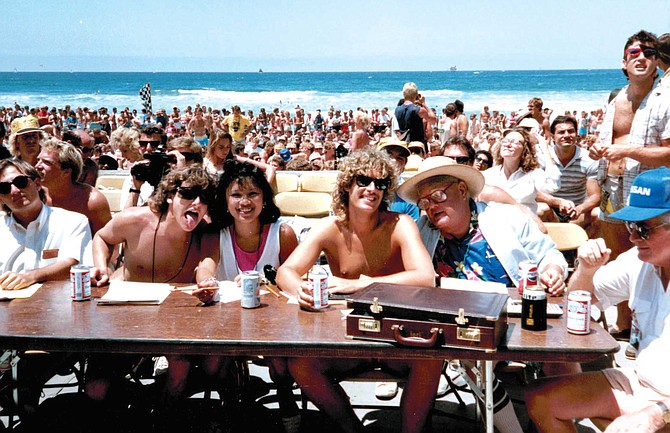
Welcome to Mission Beach, where time has stood still — sort of. Unlike Downtown, Old Town, Little Italy, and North Park, Mission Beach hasn’t been made over or “reinvented.” Drive down Mission Boulevard, which bisects the narrow isthmus south of Pacific Beach, or walk two and a half miles along the oceanfront Boardwalk, and you won’t find many changes from what things were like a generation ago. Again — sort of. The Giant Dipper roller coaster still beckons visitors from the southwest corner of Mission Boulevard and West Mission Bay Drive.
Built in 1925 by sugar magnate John D. Spreckels, the historic wooden thrill ride fell into disrepair and became one of the city’s first homeless encampments after the 1976 closure of the Belmont Park amusement park. So that was a change. But the coaster was resurrected in 1990 as the cornerstone of a new shopping center that also saw the refurbishment of another historic relic, the Mission Beach Plunge, a huge indoor swimming pool.
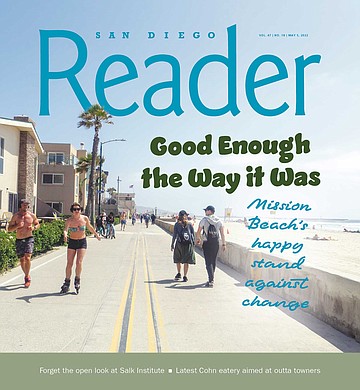
The foot of Ventura Place — which is what West Mission Bay Drive is called as it stretches west for one more block past Mission Boulevard — remains the heart of Mission Beach. And Hamel’s Action Sports Center, situated in a waterfront building remodeled many years ago to resemble a cartoonish castle, remains its soul. Bike rentals, skate repair, T-shirts, swimwear, towels, and whatever else you might need for a day in the sun, sand, and surf – it’s all there, as it has been since brothers Dan and Ray Hamel first set up shop in a former beachfront gym back in July 1967, the Summer of Love, with a starting inventory of twenty-four used Stingray bikes (purchased at a police auction) as well as two dozen surfboards.
The Mission Beach Boardwalk could be a commercial for San Diego summer – even when it’s not summer. (It is officially known as Oceanfront Walk, but everyone calls it “The Boardwalk,” even though it’s not made of wood but, rather, paved concrete.) On my last visit, during the February heat wave, there were pairs of young girls roller-skating in bikinis, their tans so even they looked airbrushed. There were teen boys on skateboards and entire families on bicycles, the majority of them rented from one of the handful of nearby bike rental shops. And there were older couples in touristy attire — floppy hats, floral prints, even an occasional fanny pack — holding each other’s hands or gripping canes.
The rest of Ventura Place also hasn’t changed much over the years. There’s still a Mexican fast-food place down on the northwest corner, at Mission Boulevard, though it was initially a Roberto’s Taco Shop and has since progressed through a series of “berto” names before settling on the current Mr. Ruriberto’s Mexican Food. Kojack’s, a Greek place just a few doors down from Hamel’s, still serves the best gyros in town, as it has since the shop was first opened by Mike Soltan back in 1983. Between Kojack’s and Mr. Ruriberto’s is still a liquor store where creeps like to hang out to watch the bikini girls shop for water and snacks, plus several T-shirt and swimwear shops, and a bar, the Coaster Saloon, that since 1982 has been one of the area’s favorite watering holes for locals, alongside the Pennant, The Beachcomber, and The Open Bar.
(The Beachcomber opened in 1961 and the Pennant, right next door, a year later. The Open Bar was launched in the 1970s as Jose Murphy’s and was rebranded in 1994.) On the other side of Mission Boulevard, just a few doors north of West Mission Bay/Ventura, is one of the city’s few surviving head shops, the appropriately named Get It On Shop, which first opened for business in 1969 and recently rebranded itself the Get It On Smoke Shop. Years ago, it was known as a smaller cousin of Ocean Beach’s celebrated The Black; today, according to its website, the Get It On Smoke Shop “specializes in glass water pipes, plus cigars, hookahs & vaporizers.”

Dwight Arnold, 60, has been coming to Mission Beach since the late ‘70s, and he lived in Pacific Beach for six years in the ‘80s when he worked for local radio station 91X. He still rides his swing bike on the Mission Beach Boardwalk at least once a week, and says the only thing that has really changed for him is that back then, he was riding a skateboard instead of a swing bike. “The atmosphere hasn’t changed much over the years,” he says. “It’s always friendly, and always fun to people watch.” While biking, he says, he still eats at the same places he’s been eating at for years, mostly little Mexican joints such as Oscar’s, La Playa, and La Perla. And he’s still down for a Bloody Mary or two at World Famous, another spot that’s as popular today as it was in the ‘80s, albeit at a different location. (It’s now at the Surfer Beach Hotel at the foot of Pacific Beach Drive, a couple of blocks south of its old location at the foot of Thomas Avenue.)
Arnold says his fondest memories include the nighttime surf events in front of Hamel’s, and the late-night, 91X-supported “grunion runs,” where he’d show up on the beach late at night in the 91X Bronco to hand out “grunion run kits” to listeners and talk on an early-edition cell phone (that was about the size of a car battery) to Billy Bones on air during the early glory days of 91X in the ‘80s. “I still run into legends like ‘SloMo’ on the Boardwalk, and still meet up with many friends who either lived there for awhile and then moved, like me — I now live in Carmel Mountain Ranch — or who are still living the life of Mission Beach.”
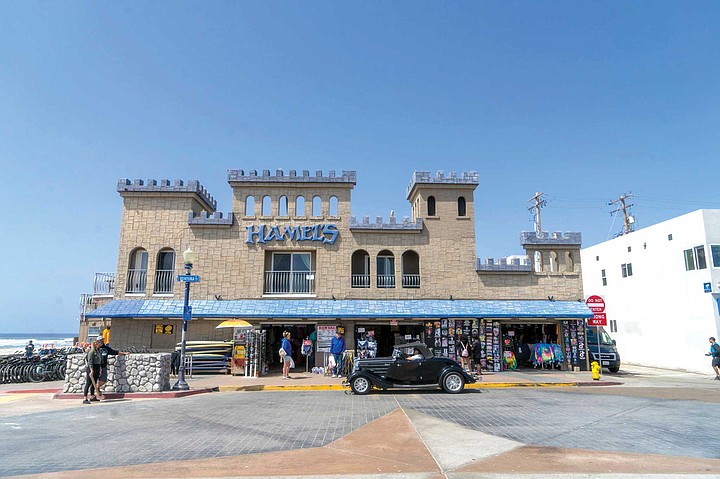
SloMo is Dr. Jon Kitchin, a wealthy medical professional who in the late 1990s began roller-skating up and down the Mission Beach Boardwalk, in slow motion, as a way to combat depression. He was profiled in the New York Times and became something of an icon; in 2020, when the city briefly shut the Boardwalk due to covid-19, the SanDiegoVille website created a petition urging city officials to reopen the Boardwalk for SloMo.
Dorian Lisa Estes, 55, grew up in Clairemont and remembers heading down Balboa Avenue to Pacific and Mission Beach virtually every day after school in the summer: “We took the 27 bus, which ran right along Balboa, or we’d hitchhike, me and all the girls, and then we’d cruise the boardwalk to the pier and to the lifeguard tower and roller-coaster. Back then, everyone was buying underage people beer. I remember saying, ‘I’m going to live here someday.’ Then when I got out of high school, I went to Santa Cruz. But then in 1987, I came back and got a place on the beach.” A quarter century later, she’s still living on the beach, this time in a house off Mission. “It’s totally the same place,” Estes says. “People are evening roller-skating again. Even the bars are the same: the Beachcomber, the Pennant. Open Bar is the same bar as when it was Jose Murphy’s; they just changed the name to get the bikers to go away. At least, that’s what they told me.”
Even the changes are consistent: Estes says many of her neighbors are returning vacationers, hailing from all over the country. “Some of my neighbors have rented the same beach house to the same families that come back to stay at the same rental properties every year, generation after generation,” she says. “Some of these families now have grown kids and even grandkids. But to them, it’s still their annual summer vacation house. I’ve met dozens and dozens of these families throughout the years. The rentals might have a new coat of paint, but it’s the vacation spot their families have grown to love, year after year. It’s amazing: they barbecue, play board games, make s’mores at a fire pit and have bonfires...”
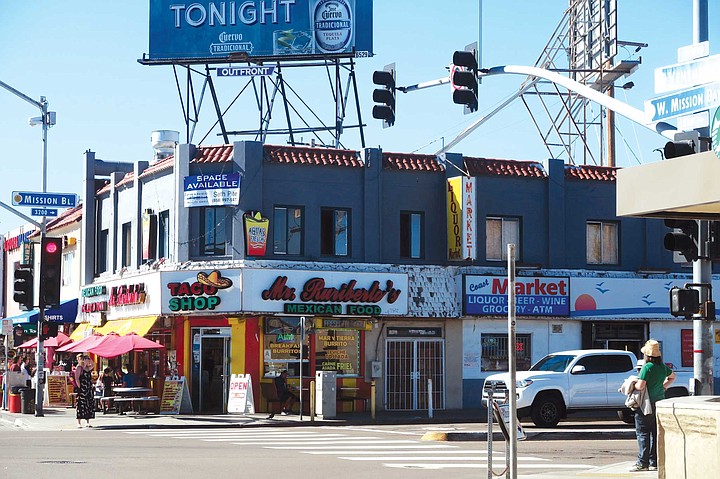
Bill Luther, a realtor who has lived and worked in Mission Beach for more than forty years, agrees that “it’s all still pretty much stayed the same. The atmosphere, the flavor, hasn’t changed much. If you were to walk up and down the Boardwalk, it’s all still Mission Beach.” It’s even true for the houses — sort of. To be sure, a good number of the homes that line the Boardwalk and Bayfront Walk on the other side of the isthmus are recent builds or remodels, some with clean, modern styling and others in the Italian Palladian style favored by McMansion builders. But a surprisingly large number of homes have been there for at least 30 years, and some for much longer.
Among them are the cluster of green-and-white cottages just south of Thomas, in what is technically Pacific Beach; the stereotypical beach bungalows at the foot of Seagirt and San Jose; and the brick-walled Brady-esque house at the foot of Toulon Court. The Surf Rider apartments at 3443 Oceanfront Walk have a newer, stylish façade, but the footprint is the same as it was in the ‘80s. And I still remember when the condos at 3665 Oceanfront Walk were built — front and center, there was a Jacuzzi, but for some sort of safety reasons, the city made the developer yank it and replace it with a little picnic table and bench underneath a pergola. (The prices, of course, they’ve changed: I remember when a three-bedroom, oceanfront condo went on sale for $385,000. I couldn’t believe how expensive it was — I had just bought a similar-size condo in Loma Alta, with a mesmerizing view of Nimitz Boulevard, for $86,500.)
Luther, however, maintains that there are more recently built homes than I might think. “The atmosphere hasn’t changed much, but there is a lot of new construction and some phenomenal architecture. Everything that’s being built now is way above average. It’s just morphed – designs got better, materials got better, and everything’s bigger. You’re getting a better product, and you’re getting people willing to pay for it.” The result is that, contrary to Estes’ perception, Luther says the “flavor of the occupants” has changed dramatically over the last three decades, with college students and longtime locals replaced by short-stay vacationers.
“The vacation rental industry changed all that,” Luther says. “In the 1980s, people had vacation homes, and they’d either come and stay themselves or rent it out to the same families, year over year. So there was a real connection with the community. Everyone knew everyone. Now, with the advent of vacation rental platforms and Internet connectivity, nobody wants to know anybody. They don’t even want to pick up the keys from the office; they say, ‘Just put it in a lockbox.’ People pay a lot of money to stay a week. It’s getting harder and harder to find a wetsuit hanging over old wooden stairs over a garage.”
Estes says part of the appeal of Mission Beach, to her, is the chance to wallow in nostalgia and relive the great memories she created as a teenager. “The sun, the boardwalk, the water – there’s something for everyone. It’s nostalgia, it’s all of that,” she says. I get what she’s saying. Some of my fondest young-adult memories stem from Mission Beach in the ‘80s (along with some not-so-fond ones). I remember judging the annual Miss Mission Beach bikini contest, hosted each summer by the Hamel brothers on the rooftop over a front section of their building.
I remember biting into thick, juicy gyros at Kojack’s and then biking up and down the Boardwalk beneath the blazing sun, the shimmering blue surf and electric white sand making me wish I’d brought along a pair of sunglasses — but no matter, there was always a cheap pair to be had at the little stand further up north, just before the Lahaina Beach House, where the balcony facing the beach was always a swirl of tanned young bodies and the beer flowed freely from the bar inside. The Boardwalk is where the blonde goddess with whom I was in love tried teaching me to roller skate; the surf is where Roger Hedgecock, just after his brief stint as San Diego mayor, tried teaching me to surf. Sadly, neither attempt was successful, so I just kept riding my bike and cooling off in the waves with my lime-green boogie board.
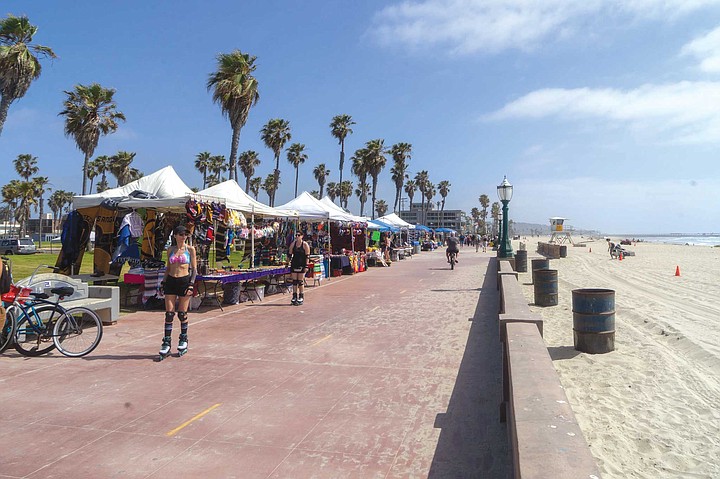
My ten years as a professional freelance journalist also quite frequently took me to Mission Beach throughout the ‘80s. I wrote about police concerns that black gangs were moving into South Mission; the controversy over the Belmont Park development on the site of the former amusement park of the same name; the arrival of police horse patrols, and the ban on alcohol on the Boardwalk. For San Diego Magazine I did a quirky feature on the beach that included an interview with an old man who had lived in the same house, just off Mission Boulevard, since the ‘30s, as well as a Q&A with the clerk at a bikini store about the latest beach fashions. And I must have written a dozen articles, if not more, about the Hamel brothers and their various squabbles with the city over things like putting signs and racks of T-shirts on the sidewalk, the homeless across the street at what for years was a vacant amusement park, and the distribution of sandbags to merchants for protection against the winter storms.
Ray Hamel, now 78, is still grousing about the city. Even though he and brother Dan have turned over their shop to a tenant, they still own the building — and still get pissed when things aren’t going the way they believe they should. Most recently, he was one of the loudest voices in the Mission Beach business community’s all-out war against the flood of street vendors hawking everything from T-shirts, straw hats and jewelry to Mexican elote and other street foods. The stretch of boardwalk between the lifeguard station and San Fernando Place was ground zero for what had become an open air flea market.
“They are ruining the community – they shouldn’t allow them out there,” Ray Hamel said. “All these other businesses are paying taxes, licenses and insurance, and then they have these guys set up right up in front of our shops. My brother won’t even go out anymore. He says he’d get so mad he couldn’t see straight. Last year, my tenant had a rack of T-shirts outside and the city gave him a $2200 fine for having them outside on the sidewalk. And yet these vendors are allowed to set up all over the place. It’s just not right.”
Kojack’s owner Mike Soltan agreed. “It’s too crowded,” he says. “And it’s not like it’s poor people working. I see vans come by early in the morning, drop tents and people off, set them up, and then they leave. Then they come back at night and take the money.” Soltan said things had gotten progressively worse over the past year. “I was on the Mission Beach planning board for 10 years, and we kept a lid on all the things around here with Kevin Faulconer. We worked with him when he was on the council and then when he became mayor. But then he took off and this is what we got. And that new councilwoman, what’s her name, Jennifer Campbell – she didn’t do much down here.” So maybe something did change, at least for a while.
The vendors began popping up three years ago, after SB 946 took effect on January 1, 2019. The new law decriminalized sidewalk vending in an effort to boost local economies. Regulating vendors was left up to cities, but San Diego had yet to do so. Last September, Campbell and Mayor Todd Gloria promised new regulations would be considered within the coming month, but nothing materialized. Finally, in a February 9 memo from Campbell, the councilmember reported that a committee has finally come up with some proposed guidelines, including requiring vendors to once again obtain a permit from the city. And in March, the council voted 8-1 to approve a measure that imposed a summer moratorium for vendors on some parts of Mission Beach and an outright ban on others.
Street vendors aside, even Ray Hamel concedes the Mission Beach of today is every bit as idyllic as it was in the late ‘80s and early ‘90s. “I think it looks pretty good,” he says. Why does he think not much has changed over the last 30 or so years? “I don’t know,” he muses. “Maybe it’s just because it’s good enough the way it was.” But it wasn’t always that way, not exactly. There was a time, back in the ‘70s and early ‘80s, when Mission Beach was run-down and dangerous. Billboards were everywhere. The Giant Dipper was falling apart. Gangs were moving into South Mission, while rowdy drunks roamed the beach, picking fights and causing trouble. And the deteriorating amusement park, which was finally shut down in December 1976 and fenced off, became a haven for transients. The renaissance began in the early ‘80s. The Hamels began staging events such as the annual Miss Mission Beach bikini contest, which drew visitors from all over the county. They and other merchants lobbied the San Diego Police Department to step up patrols in the area, particularly on the Boardwalk, and even provided them with bicycles to start regular bike patrols.
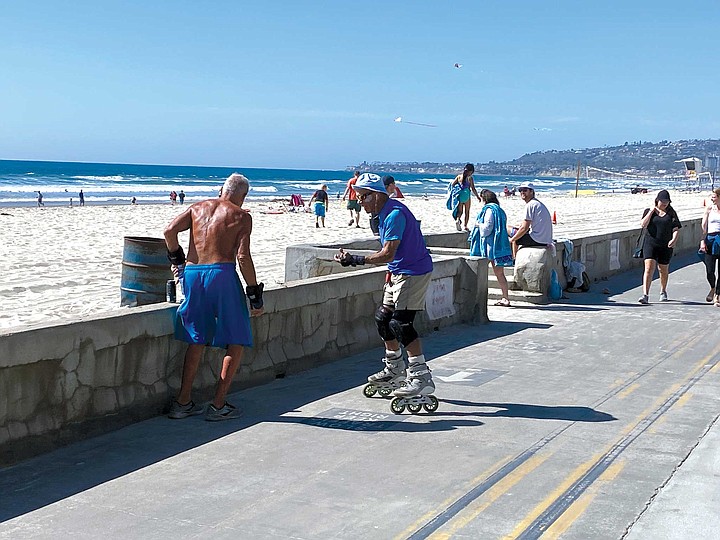
Around the same time, the late Mike Gotch, who represented the beach communities on the San Diego city council, pushed for a plan to redevelop the abandoned eighteen-acre amusement center site. It took a while, but in 1986, the council granted exclusive lease negotiation rights to architect Paul Thoryk and developer Graham MacHutchin — a move that stirred up some controversy because MacHutchin’s wife at the time, Nancy, was a primary fundraiser for Gotch. Locals, including the Hamel brothers, also didn’t like the fact that the historic plunge and roller coaster would be ringed by 70,000 feet of commercial space, mostly retail.
Regardless, plans were drawn up and approved and construction began, including a rebuild of the Plunge building, which didn’t meet earthquake code requirements. The new complex reopened in the summer of 1988, and at first, it was a rough start. The Plunge building encountered a series of problems that ultimately led to its closure in 2014 for a five-year, $12 million reconstruction. Meanwhile, a succession of retailers came and went. ”The problem with the original development was they wanted to make a shopping center, but nobody lives west of Belmont Park,” says former Council member Byron Wear, who represented the area from 1995 to 2002. Ultimately, however, the center’s focus shifted to dining and entertainment, which attracted families and tourists. Even critics like Ray Hamel will concede, “It’s much better now.”
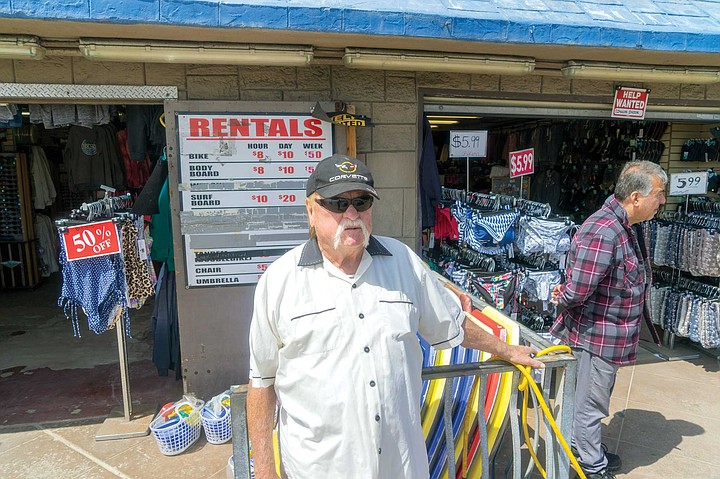
But the biggest factor that spurred the revitalization of Mission Beach, the thing that helped shape the way it looks and feels to this day, was the booze ban. No, not the citywide prohibition on alcohol consumption on city beaches that was triggered by a Labor Day 2007 riot at the foot of Reed Street in Pacific Beach, and passed into law by voters the following year. Mission Beach was, perhaps surprisingly, ahead of the game on that point: nearly two decades earlier, at the behest of the Hamels and other Mission Beach merchants, alcohol was banned from the Mission Beach Boardwalk, while drinking on the beach was temporarily outlawed between 8 pm and 8 am.
“It really cleaned it up,” says Hamel. “It was unbelievable what a difference it made. You want a drink, there are plenty of bars around. But leave the beach nice and clean – you don’t need all that rowdy stuff.” A Los Angeles Times article from August 1992, a year after alcohol use was prohibited on the Boardwalk, said Mission Beach now had “a more peaceful, family atmosphere, less litter, and a decrease in crime.” Chris Rhoades, at the time president of the Mission Beach Town Council, told the Times, “Families are back on the boardwalk. Girls can walk and ride their bikes….We had so much trouble on that Boardwalk. You wouldn’t want to walk down there in the summer unless you wanted to get harassed and groped.” The Town Council’s secretary, a woman known only as Zeva, added, “Now, you can go down the Boardwalk without it smelling like a bar and seeing litter all over the place. And I don’t have to put up with those slurry innuendoes from alcohol-ravaged dudes sitting on the wall.”
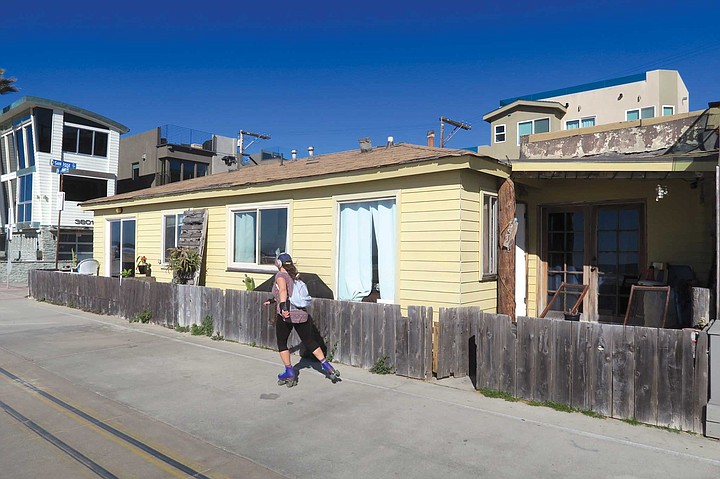
The next and perhaps final step in the revitalization of the Mission Beach Boardwalk came in 1997, when the northern two miles were widened from 15 feet to 27. The Boardwalk was originally built as a twelve-foot-wide wooden walkway on private land that had been dedicated as a public easement in 1914 by pioneering Mission Beach developer J.M. Asher. Next came a 15-foot concrete walkway, built in 1926 by the Mission Beach Company, headed by J.D. Spreckels, who also built the Plunge and the roller coaster. The public right-of-way actually extended another twelve feet to the east, but over the years, homeowners built walls, gardens, and patios, and what was officially known as Ocean Front Walk remained essentially the same for another sixty years.
Then in 1984, a city survey found that of the 180 homes, apartments and condos on Ocean Front Walk, 150 of them encroached into the dedicated right-of-way. Alarmed that the survey might be a prelude to a widening that would force them to remove what they had built over the years, residents banded together to fight any such plans. Mike Lloyd, a homeowner and lawyer, told the Los Angeles Times in 1985, “You widen that (walk) and you begin turning Mission Beach into a Venice or a Fort Lauderdale with public drunkenness, rowdiness, unchecked speeding on bicycles and roller skaters. Should we really create more room for this to occur?”
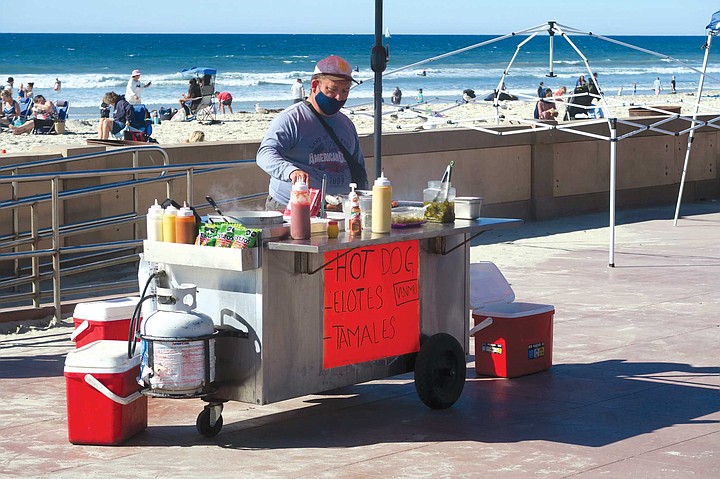
It took more than ten years, but after nearly two dozen public hearings — and despite vehement opposition from many oceanfront residents — the San Diego city council in May 1997 voted in favor of then-Councilman Bryon Wear’s plan to widen the Boardwalk north of San Fernando Court to its full allowable width of twenty-seven feet. Today, Wear has no regrets. “It gives all San Diegans plenty of access to that important beach corridor that links Mission Beach to Pacific Beach,” he says. “It was extremely controversial at the time, but it was the right policy call.”
Wear says another big reason why Mission Beach hasn’t changed much over the last thirty years is geography. “It’s the land use pattern and the scale of that community,” he says. “You have a thirty-foot height limit, you have limited width, and it’s in the coastal zone. It has no place to go, so it’s going to stay the same. What you’re going to get are more beach cottages being torn down and replaced with condos, but that’s about it.”
Future plans for Mission Beach are all centered around renovation and repair, including the original seawall, which dates back to 1925. Portions of the seawall and walkway south of the lifeguard tower at Belmont Park were rebuilt beginning in 2015, but there’s still much work to be done further north, Wear maintains.
“I know they’re planning on doing it,” Ray Hamel says, “but they just haven’t done it yet — which doesn’t surprise me.”


Welcome to Mission Beach, where time has stood still — sort of. Unlike Downtown, Old Town, Little Italy, and North Park, Mission Beach hasn’t been made over or “reinvented.” Drive down Mission Boulevard, which bisects the narrow isthmus south of Pacific Beach, or walk two and a half miles along the oceanfront Boardwalk, and you won’t find many changes from what things were like a generation ago. Again — sort of. The Giant Dipper roller coaster still beckons visitors from the southwest corner of Mission Boulevard and West Mission Bay Drive.
Built in 1925 by sugar magnate John D. Spreckels, the historic wooden thrill ride fell into disrepair and became one of the city’s first homeless encampments after the 1976 closure of the Belmont Park amusement park. So that was a change. But the coaster was resurrected in 1990 as the cornerstone of a new shopping center that also saw the refurbishment of another historic relic, the Mission Beach Plunge, a huge indoor swimming pool.

The foot of Ventura Place — which is what West Mission Bay Drive is called as it stretches west for one more block past Mission Boulevard — remains the heart of Mission Beach. And Hamel’s Action Sports Center, situated in a waterfront building remodeled many years ago to resemble a cartoonish castle, remains its soul. Bike rentals, skate repair, T-shirts, swimwear, towels, and whatever else you might need for a day in the sun, sand, and surf – it’s all there, as it has been since brothers Dan and Ray Hamel first set up shop in a former beachfront gym back in July 1967, the Summer of Love, with a starting inventory of twenty-four used Stingray bikes (purchased at a police auction) as well as two dozen surfboards.
The Mission Beach Boardwalk could be a commercial for San Diego summer – even when it’s not summer. (It is officially known as Oceanfront Walk, but everyone calls it “The Boardwalk,” even though it’s not made of wood but, rather, paved concrete.) On my last visit, during the February heat wave, there were pairs of young girls roller-skating in bikinis, their tans so even they looked airbrushed. There were teen boys on skateboards and entire families on bicycles, the majority of them rented from one of the handful of nearby bike rental shops. And there were older couples in touristy attire — floppy hats, floral prints, even an occasional fanny pack — holding each other’s hands or gripping canes.
The rest of Ventura Place also hasn’t changed much over the years. There’s still a Mexican fast-food place down on the northwest corner, at Mission Boulevard, though it was initially a Roberto’s Taco Shop and has since progressed through a series of “berto” names before settling on the current Mr. Ruriberto’s Mexican Food. Kojack’s, a Greek place just a few doors down from Hamel’s, still serves the best gyros in town, as it has since the shop was first opened by Mike Soltan back in 1983. Between Kojack’s and Mr. Ruriberto’s is still a liquor store where creeps like to hang out to watch the bikini girls shop for water and snacks, plus several T-shirt and swimwear shops, and a bar, the Coaster Saloon, that since 1982 has been one of the area’s favorite watering holes for locals, alongside the Pennant, The Beachcomber, and The Open Bar.
(The Beachcomber opened in 1961 and the Pennant, right next door, a year later. The Open Bar was launched in the 1970s as Jose Murphy’s and was rebranded in 1994.) On the other side of Mission Boulevard, just a few doors north of West Mission Bay/Ventura, is one of the city’s few surviving head shops, the appropriately named Get It On Shop, which first opened for business in 1969 and recently rebranded itself the Get It On Smoke Shop. Years ago, it was known as a smaller cousin of Ocean Beach’s celebrated The Black; today, according to its website, the Get It On Smoke Shop “specializes in glass water pipes, plus cigars, hookahs & vaporizers.”

Dwight Arnold, 60, has been coming to Mission Beach since the late ‘70s, and he lived in Pacific Beach for six years in the ‘80s when he worked for local radio station 91X. He still rides his swing bike on the Mission Beach Boardwalk at least once a week, and says the only thing that has really changed for him is that back then, he was riding a skateboard instead of a swing bike. “The atmosphere hasn’t changed much over the years,” he says. “It’s always friendly, and always fun to people watch.” While biking, he says, he still eats at the same places he’s been eating at for years, mostly little Mexican joints such as Oscar’s, La Playa, and La Perla. And he’s still down for a Bloody Mary or two at World Famous, another spot that’s as popular today as it was in the ‘80s, albeit at a different location. (It’s now at the Surfer Beach Hotel at the foot of Pacific Beach Drive, a couple of blocks south of its old location at the foot of Thomas Avenue.)
Arnold says his fondest memories include the nighttime surf events in front of Hamel’s, and the late-night, 91X-supported “grunion runs,” where he’d show up on the beach late at night in the 91X Bronco to hand out “grunion run kits” to listeners and talk on an early-edition cell phone (that was about the size of a car battery) to Billy Bones on air during the early glory days of 91X in the ‘80s. “I still run into legends like ‘SloMo’ on the Boardwalk, and still meet up with many friends who either lived there for awhile and then moved, like me — I now live in Carmel Mountain Ranch — or who are still living the life of Mission Beach.”

SloMo is Dr. Jon Kitchin, a wealthy medical professional who in the late 1990s began roller-skating up and down the Mission Beach Boardwalk, in slow motion, as a way to combat depression. He was profiled in the New York Times and became something of an icon; in 2020, when the city briefly shut the Boardwalk due to covid-19, the SanDiegoVille website created a petition urging city officials to reopen the Boardwalk for SloMo.
Dorian Lisa Estes, 55, grew up in Clairemont and remembers heading down Balboa Avenue to Pacific and Mission Beach virtually every day after school in the summer: “We took the 27 bus, which ran right along Balboa, or we’d hitchhike, me and all the girls, and then we’d cruise the boardwalk to the pier and to the lifeguard tower and roller-coaster. Back then, everyone was buying underage people beer. I remember saying, ‘I’m going to live here someday.’ Then when I got out of high school, I went to Santa Cruz. But then in 1987, I came back and got a place on the beach.” A quarter century later, she’s still living on the beach, this time in a house off Mission. “It’s totally the same place,” Estes says. “People are evening roller-skating again. Even the bars are the same: the Beachcomber, the Pennant. Open Bar is the same bar as when it was Jose Murphy’s; they just changed the name to get the bikers to go away. At least, that’s what they told me.”
Even the changes are consistent: Estes says many of her neighbors are returning vacationers, hailing from all over the country. “Some of my neighbors have rented the same beach house to the same families that come back to stay at the same rental properties every year, generation after generation,” she says. “Some of these families now have grown kids and even grandkids. But to them, it’s still their annual summer vacation house. I’ve met dozens and dozens of these families throughout the years. The rentals might have a new coat of paint, but it’s the vacation spot their families have grown to love, year after year. It’s amazing: they barbecue, play board games, make s’mores at a fire pit and have bonfires...”

Bill Luther, a realtor who has lived and worked in Mission Beach for more than forty years, agrees that “it’s all still pretty much stayed the same. The atmosphere, the flavor, hasn’t changed much. If you were to walk up and down the Boardwalk, it’s all still Mission Beach.” It’s even true for the houses — sort of. To be sure, a good number of the homes that line the Boardwalk and Bayfront Walk on the other side of the isthmus are recent builds or remodels, some with clean, modern styling and others in the Italian Palladian style favored by McMansion builders. But a surprisingly large number of homes have been there for at least 30 years, and some for much longer.
Among them are the cluster of green-and-white cottages just south of Thomas, in what is technically Pacific Beach; the stereotypical beach bungalows at the foot of Seagirt and San Jose; and the brick-walled Brady-esque house at the foot of Toulon Court. The Surf Rider apartments at 3443 Oceanfront Walk have a newer, stylish façade, but the footprint is the same as it was in the ‘80s. And I still remember when the condos at 3665 Oceanfront Walk were built — front and center, there was a Jacuzzi, but for some sort of safety reasons, the city made the developer yank it and replace it with a little picnic table and bench underneath a pergola. (The prices, of course, they’ve changed: I remember when a three-bedroom, oceanfront condo went on sale for $385,000. I couldn’t believe how expensive it was — I had just bought a similar-size condo in Loma Alta, with a mesmerizing view of Nimitz Boulevard, for $86,500.)
Luther, however, maintains that there are more recently built homes than I might think. “The atmosphere hasn’t changed much, but there is a lot of new construction and some phenomenal architecture. Everything that’s being built now is way above average. It’s just morphed – designs got better, materials got better, and everything’s bigger. You’re getting a better product, and you’re getting people willing to pay for it.” The result is that, contrary to Estes’ perception, Luther says the “flavor of the occupants” has changed dramatically over the last three decades, with college students and longtime locals replaced by short-stay vacationers.
“The vacation rental industry changed all that,” Luther says. “In the 1980s, people had vacation homes, and they’d either come and stay themselves or rent it out to the same families, year over year. So there was a real connection with the community. Everyone knew everyone. Now, with the advent of vacation rental platforms and Internet connectivity, nobody wants to know anybody. They don’t even want to pick up the keys from the office; they say, ‘Just put it in a lockbox.’ People pay a lot of money to stay a week. It’s getting harder and harder to find a wetsuit hanging over old wooden stairs over a garage.”
Estes says part of the appeal of Mission Beach, to her, is the chance to wallow in nostalgia and relive the great memories she created as a teenager. “The sun, the boardwalk, the water – there’s something for everyone. It’s nostalgia, it’s all of that,” she says. I get what she’s saying. Some of my fondest young-adult memories stem from Mission Beach in the ‘80s (along with some not-so-fond ones). I remember judging the annual Miss Mission Beach bikini contest, hosted each summer by the Hamel brothers on the rooftop over a front section of their building.
I remember biting into thick, juicy gyros at Kojack’s and then biking up and down the Boardwalk beneath the blazing sun, the shimmering blue surf and electric white sand making me wish I’d brought along a pair of sunglasses — but no matter, there was always a cheap pair to be had at the little stand further up north, just before the Lahaina Beach House, where the balcony facing the beach was always a swirl of tanned young bodies and the beer flowed freely from the bar inside. The Boardwalk is where the blonde goddess with whom I was in love tried teaching me to roller skate; the surf is where Roger Hedgecock, just after his brief stint as San Diego mayor, tried teaching me to surf. Sadly, neither attempt was successful, so I just kept riding my bike and cooling off in the waves with my lime-green boogie board.

My ten years as a professional freelance journalist also quite frequently took me to Mission Beach throughout the ‘80s. I wrote about police concerns that black gangs were moving into South Mission; the controversy over the Belmont Park development on the site of the former amusement park of the same name; the arrival of police horse patrols, and the ban on alcohol on the Boardwalk. For San Diego Magazine I did a quirky feature on the beach that included an interview with an old man who had lived in the same house, just off Mission Boulevard, since the ‘30s, as well as a Q&A with the clerk at a bikini store about the latest beach fashions. And I must have written a dozen articles, if not more, about the Hamel brothers and their various squabbles with the city over things like putting signs and racks of T-shirts on the sidewalk, the homeless across the street at what for years was a vacant amusement park, and the distribution of sandbags to merchants for protection against the winter storms.
Ray Hamel, now 78, is still grousing about the city. Even though he and brother Dan have turned over their shop to a tenant, they still own the building — and still get pissed when things aren’t going the way they believe they should. Most recently, he was one of the loudest voices in the Mission Beach business community’s all-out war against the flood of street vendors hawking everything from T-shirts, straw hats and jewelry to Mexican elote and other street foods. The stretch of boardwalk between the lifeguard station and San Fernando Place was ground zero for what had become an open air flea market.
“They are ruining the community – they shouldn’t allow them out there,” Ray Hamel said. “All these other businesses are paying taxes, licenses and insurance, and then they have these guys set up right up in front of our shops. My brother won’t even go out anymore. He says he’d get so mad he couldn’t see straight. Last year, my tenant had a rack of T-shirts outside and the city gave him a $2200 fine for having them outside on the sidewalk. And yet these vendors are allowed to set up all over the place. It’s just not right.”
Kojack’s owner Mike Soltan agreed. “It’s too crowded,” he says. “And it’s not like it’s poor people working. I see vans come by early in the morning, drop tents and people off, set them up, and then they leave. Then they come back at night and take the money.” Soltan said things had gotten progressively worse over the past year. “I was on the Mission Beach planning board for 10 years, and we kept a lid on all the things around here with Kevin Faulconer. We worked with him when he was on the council and then when he became mayor. But then he took off and this is what we got. And that new councilwoman, what’s her name, Jennifer Campbell – she didn’t do much down here.” So maybe something did change, at least for a while.
The vendors began popping up three years ago, after SB 946 took effect on January 1, 2019. The new law decriminalized sidewalk vending in an effort to boost local economies. Regulating vendors was left up to cities, but San Diego had yet to do so. Last September, Campbell and Mayor Todd Gloria promised new regulations would be considered within the coming month, but nothing materialized. Finally, in a February 9 memo from Campbell, the councilmember reported that a committee has finally come up with some proposed guidelines, including requiring vendors to once again obtain a permit from the city. And in March, the council voted 8-1 to approve a measure that imposed a summer moratorium for vendors on some parts of Mission Beach and an outright ban on others.
Street vendors aside, even Ray Hamel concedes the Mission Beach of today is every bit as idyllic as it was in the late ‘80s and early ‘90s. “I think it looks pretty good,” he says. Why does he think not much has changed over the last 30 or so years? “I don’t know,” he muses. “Maybe it’s just because it’s good enough the way it was.” But it wasn’t always that way, not exactly. There was a time, back in the ‘70s and early ‘80s, when Mission Beach was run-down and dangerous. Billboards were everywhere. The Giant Dipper was falling apart. Gangs were moving into South Mission, while rowdy drunks roamed the beach, picking fights and causing trouble. And the deteriorating amusement park, which was finally shut down in December 1976 and fenced off, became a haven for transients. The renaissance began in the early ‘80s. The Hamels began staging events such as the annual Miss Mission Beach bikini contest, which drew visitors from all over the county. They and other merchants lobbied the San Diego Police Department to step up patrols in the area, particularly on the Boardwalk, and even provided them with bicycles to start regular bike patrols.

Around the same time, the late Mike Gotch, who represented the beach communities on the San Diego city council, pushed for a plan to redevelop the abandoned eighteen-acre amusement center site. It took a while, but in 1986, the council granted exclusive lease negotiation rights to architect Paul Thoryk and developer Graham MacHutchin — a move that stirred up some controversy because MacHutchin’s wife at the time, Nancy, was a primary fundraiser for Gotch. Locals, including the Hamel brothers, also didn’t like the fact that the historic plunge and roller coaster would be ringed by 70,000 feet of commercial space, mostly retail.
Regardless, plans were drawn up and approved and construction began, including a rebuild of the Plunge building, which didn’t meet earthquake code requirements. The new complex reopened in the summer of 1988, and at first, it was a rough start. The Plunge building encountered a series of problems that ultimately led to its closure in 2014 for a five-year, $12 million reconstruction. Meanwhile, a succession of retailers came and went. ”The problem with the original development was they wanted to make a shopping center, but nobody lives west of Belmont Park,” says former Council member Byron Wear, who represented the area from 1995 to 2002. Ultimately, however, the center’s focus shifted to dining and entertainment, which attracted families and tourists. Even critics like Ray Hamel will concede, “It’s much better now.”

But the biggest factor that spurred the revitalization of Mission Beach, the thing that helped shape the way it looks and feels to this day, was the booze ban. No, not the citywide prohibition on alcohol consumption on city beaches that was triggered by a Labor Day 2007 riot at the foot of Reed Street in Pacific Beach, and passed into law by voters the following year. Mission Beach was, perhaps surprisingly, ahead of the game on that point: nearly two decades earlier, at the behest of the Hamels and other Mission Beach merchants, alcohol was banned from the Mission Beach Boardwalk, while drinking on the beach was temporarily outlawed between 8 pm and 8 am.
“It really cleaned it up,” says Hamel. “It was unbelievable what a difference it made. You want a drink, there are plenty of bars around. But leave the beach nice and clean – you don’t need all that rowdy stuff.” A Los Angeles Times article from August 1992, a year after alcohol use was prohibited on the Boardwalk, said Mission Beach now had “a more peaceful, family atmosphere, less litter, and a decrease in crime.” Chris Rhoades, at the time president of the Mission Beach Town Council, told the Times, “Families are back on the boardwalk. Girls can walk and ride their bikes….We had so much trouble on that Boardwalk. You wouldn’t want to walk down there in the summer unless you wanted to get harassed and groped.” The Town Council’s secretary, a woman known only as Zeva, added, “Now, you can go down the Boardwalk without it smelling like a bar and seeing litter all over the place. And I don’t have to put up with those slurry innuendoes from alcohol-ravaged dudes sitting on the wall.”

The next and perhaps final step in the revitalization of the Mission Beach Boardwalk came in 1997, when the northern two miles were widened from 15 feet to 27. The Boardwalk was originally built as a twelve-foot-wide wooden walkway on private land that had been dedicated as a public easement in 1914 by pioneering Mission Beach developer J.M. Asher. Next came a 15-foot concrete walkway, built in 1926 by the Mission Beach Company, headed by J.D. Spreckels, who also built the Plunge and the roller coaster. The public right-of-way actually extended another twelve feet to the east, but over the years, homeowners built walls, gardens, and patios, and what was officially known as Ocean Front Walk remained essentially the same for another sixty years.
Then in 1984, a city survey found that of the 180 homes, apartments and condos on Ocean Front Walk, 150 of them encroached into the dedicated right-of-way. Alarmed that the survey might be a prelude to a widening that would force them to remove what they had built over the years, residents banded together to fight any such plans. Mike Lloyd, a homeowner and lawyer, told the Los Angeles Times in 1985, “You widen that (walk) and you begin turning Mission Beach into a Venice or a Fort Lauderdale with public drunkenness, rowdiness, unchecked speeding on bicycles and roller skaters. Should we really create more room for this to occur?”

It took more than ten years, but after nearly two dozen public hearings — and despite vehement opposition from many oceanfront residents — the San Diego city council in May 1997 voted in favor of then-Councilman Bryon Wear’s plan to widen the Boardwalk north of San Fernando Court to its full allowable width of twenty-seven feet. Today, Wear has no regrets. “It gives all San Diegans plenty of access to that important beach corridor that links Mission Beach to Pacific Beach,” he says. “It was extremely controversial at the time, but it was the right policy call.”
Wear says another big reason why Mission Beach hasn’t changed much over the last thirty years is geography. “It’s the land use pattern and the scale of that community,” he says. “You have a thirty-foot height limit, you have limited width, and it’s in the coastal zone. It has no place to go, so it’s going to stay the same. What you’re going to get are more beach cottages being torn down and replaced with condos, but that’s about it.”
Future plans for Mission Beach are all centered around renovation and repair, including the original seawall, which dates back to 1925. Portions of the seawall and walkway south of the lifeguard tower at Belmont Park were rebuilt beginning in 2015, but there’s still much work to be done further north, Wear maintains.
“I know they’re planning on doing it,” Ray Hamel says, “but they just haven’t done it yet — which doesn’t surprise me.”
Comments